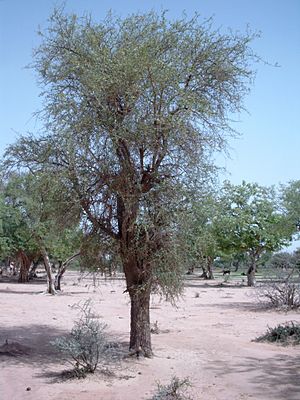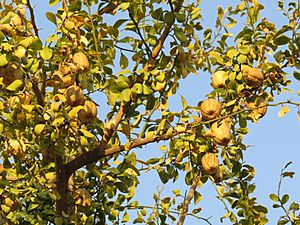Balanites aegyptiaca facts for kids
Quick facts for kids Balanites aegyptiaca |
|
|---|---|
 |
|
| Scientific classification | |
| Genus: |
Balanites
|
| Species: |
aegyptiaca
|
| Synonyms | |
|
|
The Balanites aegyptiaca is a special kind of tree. It is also known as the Egyptian balsam or desert date. This tree grows naturally in many parts of Africa and some areas of the Middle East. It belongs to a plant family called Zygophyllaceae or Balanitaceae.
This amazing plant has many different names. In English, people call its fruit the desert date, soap berry tree, or thorn tree. Other names include Egyptian myrobalan, Egyptian balsam, or Zachum oil tree. In Arabic, it is known as lalob or heglig. In other languages, it has names like Thou, aduwa, taboraq, Murtooki, mchunju, Kilului, and bedena.
Contents
Where the Desert Date Tree Grows
The Balanites aegyptiaca tree is found in many places. You can see it in North Eastern Africa, Egypt, and the Sahel-Savannah region. This area stretches across Africa and the Arabian Peninsula.
This tree is very tough. It can grow in many different types of places. It doesn't mind if the soil is sandy or heavy clay. It also handles different amounts of rain, from very dry to somewhat wet areas. The tree can even survive floods, lots of animal activity, and wildfires.
What the Tree Looks Like
The Balanites aegyptiaca tree can grow up to 10 m (33 ft) tall. It usually has a narrow shape. Its branches have long, straight green thorns that grow in a spiral pattern. The dark green leaves grow at the base of these thorns. Each leaf has two smaller parts that can look different. The tree's trunk is grooved and has grayish-brown bark. You might see yellow-green spots where the bark peels off.
The tree's flowers grow in small groups. They are greenish-yellow and have five petals. Each flower is about 8–14 millimetres (0.31–0.55 in) wide. These flowers can grow into ellipsoid-shaped fruits. The fruit is usually less than 4 cm (1.6 in) long. It starts green and turns brown or pale brown when it's ripe. The fruit has a crispy skin. Inside, there is a sticky brown or green-brown pulp around a hard stone.
Some insects like this tree. The carpenter ant Camponotus sericeus eats the sweet liquid from the flowers. The larva of the cabbage tree emperor moth, called Bunaea alcinoe, can eat the tree's leaves.
How People Use the Tree
Food from the Tree
People in Egypt have grown Balanites aegyptiaca for over 4000 years. Ancient Egyptians even placed the fruit stones in tombs as special offerings. This shows how important the tree was to them.
The yellow fruit has one seed and is safe to eat. However, it can be a bit bitter. In Africa, many parts of this plant are used as food during tough times. People eat the leaves raw or cooked. The oily seed is boiled to make it less bitter, then mixed with sorghum. The flowers can also be eaten. This tree is very helpful in dry areas because it still produces fruit when other plants struggle. The fruit can also be used to make alcoholic drinks.
After oil is taken from the seeds, the leftover part is often used as animal food. The seeds also have a special effect that can kill freshwater snails. These snails can carry harmful parasites. African elephants also enjoy eating the desert date fruit where they live.
Medicinal Uses
The desert date fruit is sometimes mixed into porridge for nursing mothers. The oil from the tree is used to help with headaches and to improve milk production.
Extracts from the bark and fruit can get rid of freshwater snails and tiny creatures called copepods. These small animals can carry parasites that cause diseases like schistosomiasis and guinea worm. People also use the desert date to treat worm infections. It is also used for problems with the liver and spleen. In West African traditional medicine, a special liquid made from the bark is used as an antidote for arrow poison.
The seeds of the tree contain a lot of oil, about 30-48%. The leaves, fruit pulp, bark, and roots also contain useful substances called sapogenins and saponins.
Tree Farming and Other Uses
People manage this tree using a method called agroforestry. This means they grow trees alongside crops or animals. The tree is planted near irrigation canals to attract insects for trapping. The wood is pale to brownish yellow. It is used to make furniture and strong items like tools. It also makes good firewood that produces little smoke and excellent charcoal.
Smaller trees and branches are used to make fences. They are strong and thorny, which makes them good barriers. The tree also helps the soil by adding nitrogen. It is grown in special farms in some areas just for its fruit. The bark gives us fibers. The sticky natural gum from the branches is used as glue. The seeds have even been used to make jewelry and beads.
Tattoos
Some tribes in the Sahel region use the tree's thorns. They use them to make small cuts on the skin that create tattoos.
About the Name
The first part of the tree's scientific name, Balanites, comes from a Greek word. It means "acorn" and refers to the shape of the fruit. This name was given by Alire Raffeneau Delile in 1813. The second part, aegyptiaca, means "from Egypt." Carl Linnaeus gave it this name because the first samples of the tree were found in Egypt.
See also
 In Spanish: Datilero del desierto para niños
In Spanish: Datilero del desierto para niños




